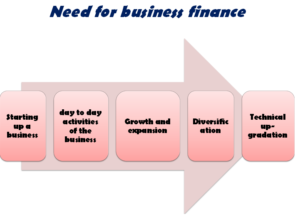What is business finance class 12, When can know the answer to this question by going through this document as it explains the concept of business finance and why any organization needs business finance. All the information related to the topic is given below.
Meaning of Business Finance
Business finance is the money required for the business – to carry out different activities of the business. Business finance plays a very important role in any business, be it, retail, wholesale, public, private, economic business, social business, or political. Finance is required everywhere, even in nongovernment organizations (NGOs).
Finance is required for different kinds of activities such as running the business, expanding the business, growth, development of the business, modernization, diversification, technological up-gradation, etc.
Businesses need finance for their assets also. Assets can be classified into two categories, tangible and intangible assets. The tangible assets are the ones that the business can see or touch such as raw materials, machinery, manpower, factories, buildings, etc. The intangible assets are the ones that the business cannot see nor touch such as copyrights, trademarks, goodwill, patents, technical expertise, brand recognition, intellectual property rights, etc.
Need for business finance under What is business finance
There are various areas in the business where business finance is required. These areas are an integral part of the business’s work. They are:

Starting a business
Finance is required at each stage of the business. The first step is setting up a business and before starting, finance is required. Finance is needed to accumulate the resources for the business. These resources include raw materials, machinery, and manpower. Other assets are also acquired by business finance such as patents, copyrights, etc.
Day to day activities of the businesses under What is business finance
Businesses not only require finance at the first stage but also require finance in day-to-day operations such as buying raw materials from the supplier, paying wages to the workers, buying liquid assets, etc.
Growth and expansion
Business finance is needed for the growth and expansion of the business. When the business starts running efficiently, then it is time to grow the business in size or variety or investment in more fixed capital. Higher growth or expansion will require a higher investment in finance.
Diversification under What is business finance
When any business finds the idea of diversifying the business into other areas then they will require finance. It becomes similar to starting up a new business but with an already-established brand name.
Technological up-gradation
Many times, businesses require technological up-gradation for their business to run smoothly or to cut costs. For adopting the new/modern technology, investment is required and thus business finance comes into the scene.
Sources of business finance under What is business finance
There are various sources for raising business finance. Not all businesses start with their own/personal investment. Some of the sources are as follows:
- Equity shares
- Preference shares
- Debentures
- Loan from banks
- Public deposits
- Commercial paper
- Retained earnings
- Lease financing
- Trade credit
- Factoring
Factors affecting the choice of finance
There are different sources of finance and they are affected by the following:
- Amount of finance required
- How quickly it is required
- The activity it is required for
- The cost involved/ cheapest option available
- Lowest risk associated
- Duration of time it is required for (long term/medium term/ short term)
Finances do not come for free, they come with some risk and cost, and thus they need to be managed properly. Financial management is thus the process or activity of optimum procurement and optimal usage of business finance.
Financial management is thus the process that includes:
- Identifying the various sources of finance
- Comparing these sources of finance based on the cost and risk associated with it.
- Make the best possible investment that provides returns higher than the cost.
Financial management has the function of ensuring the availability of finance to the business whenever required, thus helping in avoiding the shortage of finance and at the same time avoiding the excess of finance (idle finance)
The financial health of the business is directly or indirectly affected by the financial decisions that are taken by the firm and it is an important part of financial management. Some major areas of financial management are as under:
- Fixed assets of the firm: when the company decides about the size of the business, its fixed assets’ composition, then the business finance is affected. For example the investment of rs. 20 crores in machinery will directly impact the size of fixed assets and the finances of the firm.
- Proper allocation of funds in capital assets: finances are also required for the current assets such as cash, inventories, or receivables. The quantum of current assets will affect the financial decisions of the firm directly.
- Long-term and short-term finance and its composition: long-term and short-term finance and its composition depending on the choice made by the firm. It depends on whether the firm wants more liquidity or profitability. Attracting new capital depends on the level of profitability of the firm.
This is thus a cycle. Current financial decisions affect the financial statements of the firm and future financial decisions depend upon the current financial statements. Thus the health of business finance is closely related to the financial management of the firm. Obtaining the finances at a lower risk and lower cost and deployment of these finances into the most lucrative activities where the returns are higher is the main role of the financial management but it also affects the excess of finances or shortage of finance and thus helps in balancing the composition of long term and short term finances and debt and equity.
BST Chapter 9 – Financial Management